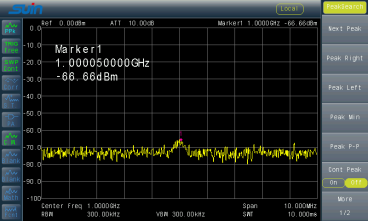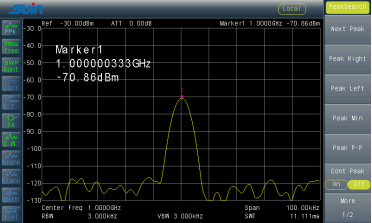News
Jun. 21, 2024
Small signals usually refer to signals whose amplitude is well below the noise level of the spectrum analyzer. These signals may be weak due to their own characteristics or due to attenuation during transmission. The main challenge when measuring small signals is to distinguish the signal from instrument noise or external interference.
We take SA9275 spectrum analyzers as an example to show how to measure small signals by spectrum analyzer.With the right setup and techniques, even very small signals can be effectively measured and analyzed.
First, give a 1GHz sine signal with -70dBm amplitude directly output to the spectrum analyzer.
Then, set the center frequency of the spectrum analyzer to 1GHz and the span to 100MHz. There was no waveforms on the spectrum analyzer,as shown in figure 1. At this time, the bottom noise of the spectrum analyzer has reached -70dBm, the output signal amplitude is too small, directly drowned in the bottom noise of the spectrum analyzer.

Fig 1. Original Waveform
At this time you need to reduce the bottom noise of the spectrum analyzer, you can first set the input attenuation of the signal, with the reduction of the input attenuation, the difference between the small signal and the bottom noise is getting bigger and bigger. when the attenuation is completely closed,that means the attenuation reach 0. By turning on the preamplifier, the bottom noise of the spectrum analyzer has been reduced to -120dBm or so, the difference between the small signal is getting bigger and bigger, and it is completely distinguished from the bottom noise, we can get the frequency of small signal is 1GHz and the amplitude is -70dBm,as shown in figure 2.

Fig 2. Small signal
Suin manufactures a wide range of analyzers and instruments to cater to different tests and needs. Contact us for support and expertise in selecting the best spectrum analyzer for your project.